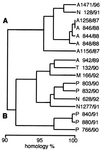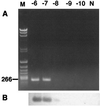Application of a reverse transcription-PCR for identification and differentiation of Aichi virus, a new member of the Picornavirus family associated with gastroenteritis in humans
- PMID: 10921958
- PMCID: PMC87158
- DOI: 10.1128/JCM.38.8.2955-2961.2000
Application of a reverse transcription-PCR for identification and differentiation of Aichi virus, a new member of the Picornavirus family associated with gastroenteritis in humans
Abstract
Aichi viruses isolated in Vero cells from seven patients in five gastroenteritis outbreaks in Japan, five Japanese returning from Southeast Asian countries, and five local children in Pakistan with gastroenteritis were examined for differentiation based on their reactivities with a monoclonal antibody to a standard strain (A846/88) and a reverse transcription-PCR (RT-PCR) of three genomic regions. The RNA sequences were determined for 519 bases of these 17 isolates at the putative junction between the C terminus of 3C and the N terminus of 3D. The analyses revealed an approximately 90% homology between these isolates, which were then divided into two groups: group 1 (genotype A) included six isolates from four outbreaks and one isolate from a traveler and group 2 (genotype B) included one isolate from the other outbreak, four isolates from returning travelers, and all of the isolates from the Pakistani children. Based on the isolate sequences, a primer pair and a biotin-labeled probe were designed for amplification and detection of 223 bases at the 3C-3D junction of Aichi virus RNA in fecal specimens. The Aichi virus RNA was detected in 54 (55%) of 99 fecal specimens from the patients in 12 (32%) of 37 outbreaks of gastroenteritis in Japan. Of the 12 outbreaks, 11 were suspected to be due to genotype A. These results indicated that RT-PCR can be a useful tool to detect Aichi virus in stool samples and that a sequence analysis of PCR products can be employed to identify the prevalent strain in each incident.
Figures




Similar articles
-
Identification of Aichi virus infection by measurement of immunoglobulin responses in an enzyme-linked immunosorbent assay.J Clin Microbiol. 2001 Nov;39(11):4178-80. doi: 10.1128/JCM.39.11.4178-4180.2001. J Clin Microbiol. 2001. PMID: 11682554 Free PMC article.
-
Molecular characterization of the first Aichi viruses isolated in Europe and in South America.Arch Virol. 2006 Jun;151(6):1199-206. doi: 10.1007/s00705-005-0706-7. Epub 2006 Jan 19. Arch Virol. 2006. PMID: 16421634
-
Prevalence and genetic diversity of Aichi virus strains in stool samples from community and hospitalized patients.J Clin Microbiol. 2008 Apr;46(4):1252-8. doi: 10.1128/JCM.02140-07. Epub 2008 Feb 6. J Clin Microbiol. 2008. PMID: 18256215 Free PMC article.
-
[Biological and epidemiological characteristics of Aichi virus, as a new member of Picornaviridae].Uirusu. 1999 Dec;49(2):183-91. doi: 10.2222/jsv.49.183. Uirusu. 1999. PMID: 10737116 Review. Japanese. No abstract available.
-
Saliviruses-the first knowledge about a newly discovered human picornavirus.Rev Med Virol. 2017 Jan;27(1). doi: 10.1002/rmv.1904. Epub 2016 Sep 19. Rev Med Virol. 2017. PMID: 27641729 Review.
Cited by
-
ACBD3-mediated recruitment of PI4KB to picornavirus RNA replication sites.EMBO J. 2012 Feb 1;31(3):754-66. doi: 10.1038/emboj.2011.429. Epub 2011 Nov 29. EMBO J. 2012. PMID: 22124328 Free PMC article.
-
Prevalence and Genetic Diversity of Enteric Viruses in Children with Diarrhea in Ouagadougou, Burkina Faso.PLoS One. 2016 Apr 19;11(4):e0153652. doi: 10.1371/journal.pone.0153652. eCollection 2016. PLoS One. 2016. PMID: 27092779 Free PMC article.
-
Identification of Aichi virus infection by measurement of immunoglobulin responses in an enzyme-linked immunosorbent assay.J Clin Microbiol. 2001 Nov;39(11):4178-80. doi: 10.1128/JCM.39.11.4178-4180.2001. J Clin Microbiol. 2001. PMID: 11682554 Free PMC article.
-
Advances in Diagnostic Approaches for Viral Etiologies of Diarrhea: From the Lab to the Field.Front Microbiol. 2019 Sep 13;10:1957. doi: 10.3389/fmicb.2019.01957. eCollection 2019. Front Microbiol. 2019. PMID: 31608017 Free PMC article. Review.
-
Aichi virus IgG seroprevalence in Tunisia parallels genomic detection and clinical presentation in children with gastroenteritis.Clin Vaccine Immunol. 2010 Jul;17(7):1111-6. doi: 10.1128/CVI.00059-10. Epub 2010 May 19. Clin Vaccine Immunol. 2010. PMID: 20484569 Free PMC article.
References
-
- Al-Nakib W. Rhinoviruses. In: Zuckerman A J, Banatvala J E, Pattison J R, editors. Principles and practice of clinical virology. 2nd ed. Chichester, England: John Wiley & Sons; 1990. pp. 289–303.
-
- Blacklow N R. Medical virology of small round gastroenteritis viruses. Med Virol. 1998;9:111–128. - PubMed
-
- Cubitt W D. The candidate caliciviruses. Ciba Found Symp. 1987;128:126–143. - PubMed
MeSH terms
Substances
Associated data
- Actions
- Actions
- Actions
- Actions
- Actions
- Actions
- Actions
- Actions
- Actions
- Actions
- Actions
- Actions
- Actions
- Actions
- Actions
LinkOut - more resources
Full Text Sources
Medical

